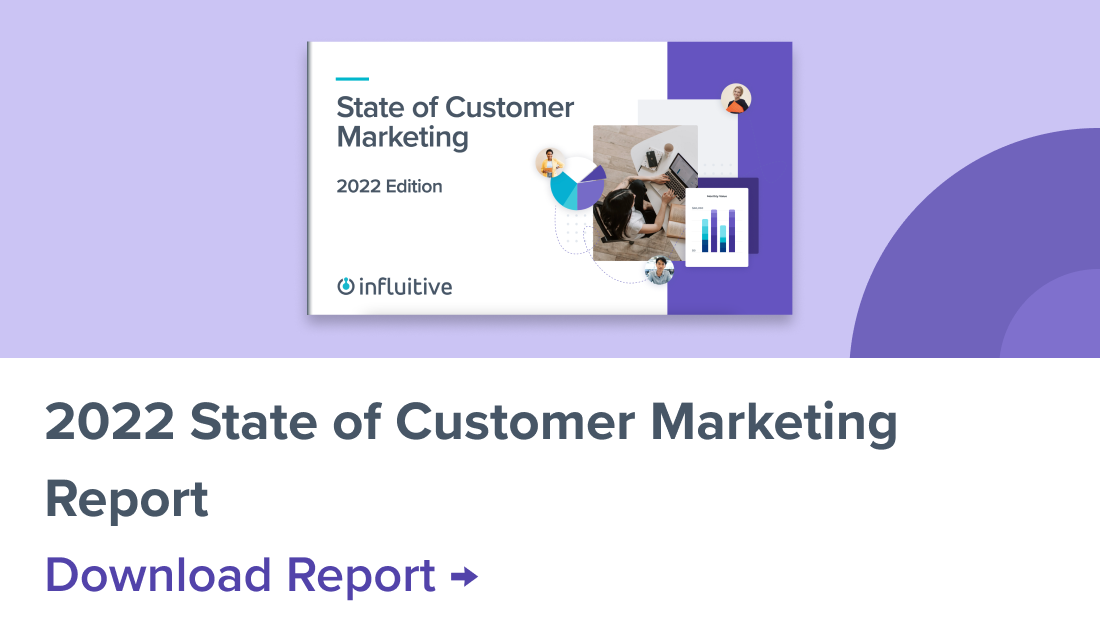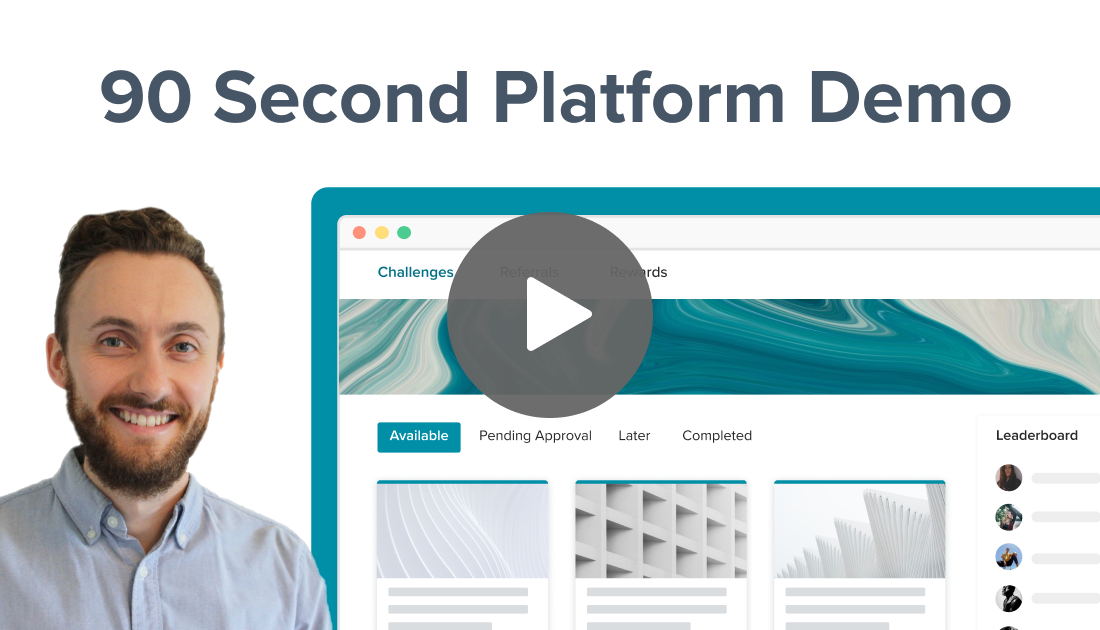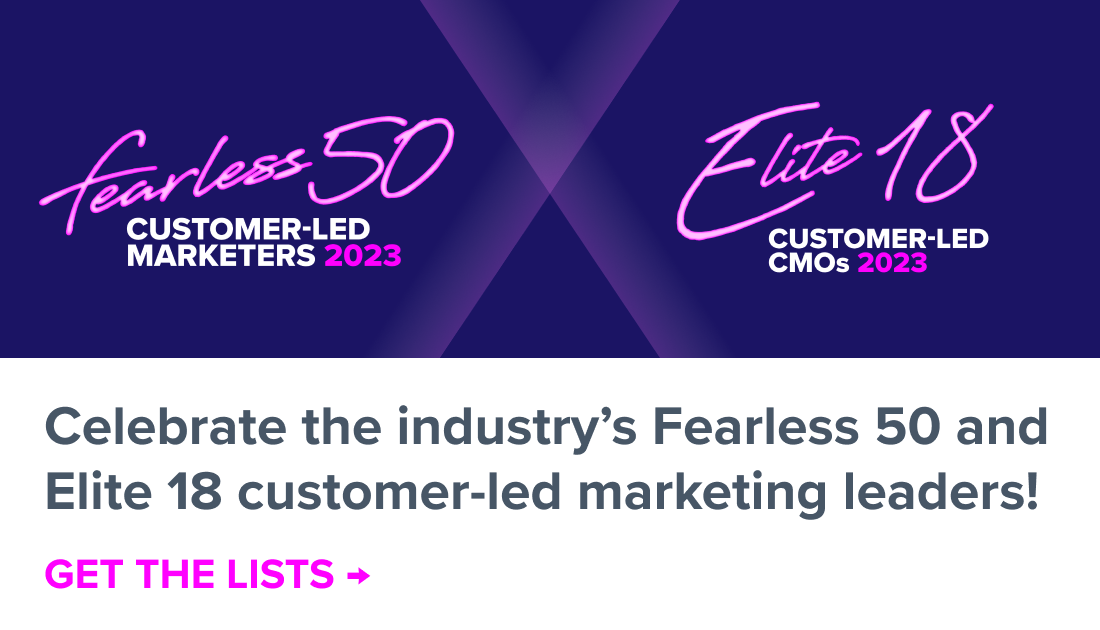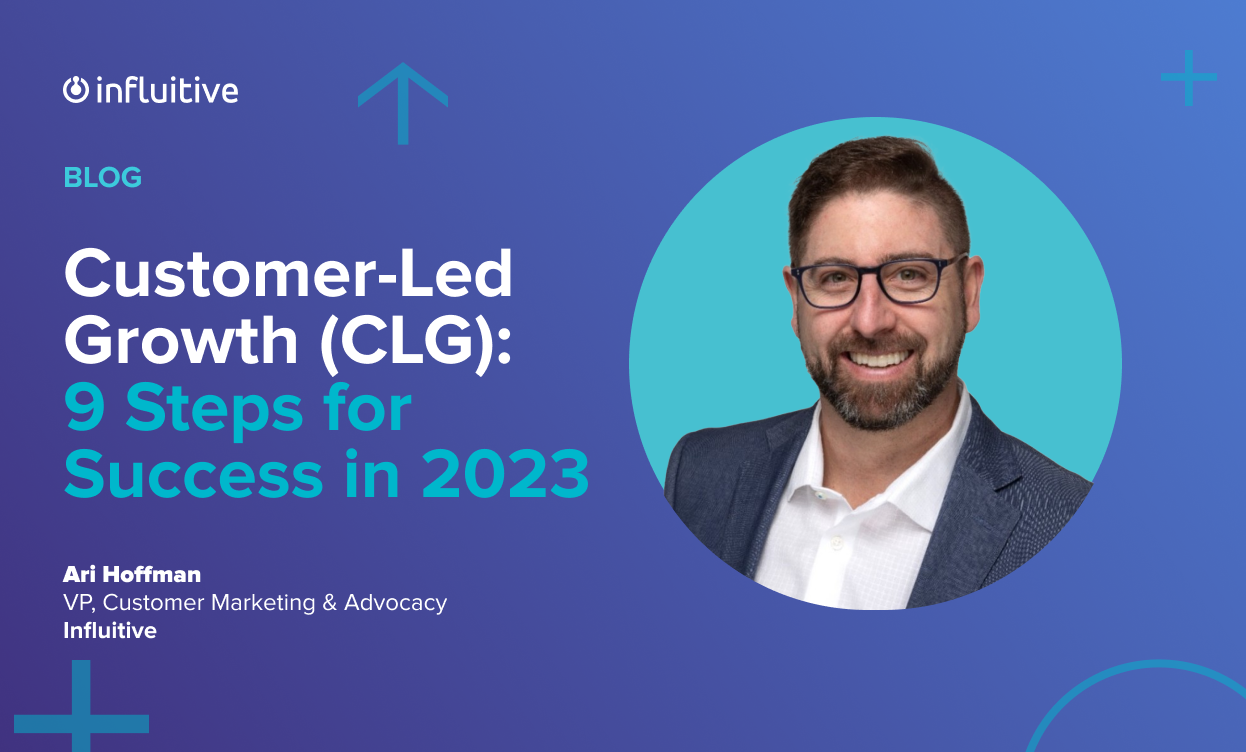Businesses need to start moving away from a typical growth mindset and embrace a customer-led growth strategy.
Why?
Customer-led growth (GLC) puts customers at the center of everything you do and prioritizes their insights to optimize their experience and grow your business. And who knows your business better than your customers?
While growth-minded businesses focus on sourcing leads, nurturing prospects, and creating sales processes that generate improved conversions, these efforts consume a ton of resources and ultimately lead to diminishing rates of return. In some cases, opportunities that seemed destined to convert evaporate, and it can be very difficult to determine what went wrong.
But how do you actually make this shift? In this post, I’ll dive into what CLG is and why it’s important, a nine-step process for building a CLG strategy, and share some of the top companies that are executing it.
What is customer-led growth (CLG), exactly?
Customer-led growth is a business strategy that uses customer feedback to improve the customer experience and optimize or develop products for customers.
CLG enhances the symbiotic relationship between a business and its customer because the insights businesses garner from their customers help them develop products that customers want, which in turn increases customer satisfaction, brand advocacy, and sales revenue. Here’s an example of how CLG works:
Church & Dwight — manufacturers of Arm & Hammer Baking Soda — asked customers how they use that product. The company learned that customers had a lot of “off-label” uses for the product, like freshening carpets before vacuuming and removing stubborn stains in the laundry. With that information, Church & Dwight developed a wide range of new products under the Arm & Hammer brand.
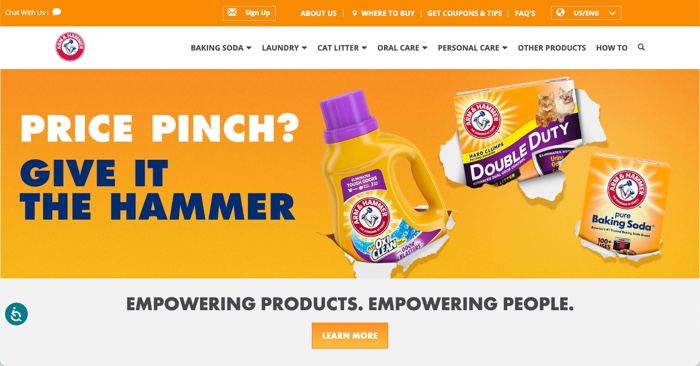
Baking soda now accounts for less than 10% of Arm & Hammer’s B2C revenue, but the brand’s share value has grown significantly, compared to its competitors.
Core principles of CLG
While businesses may vary in how they talk about CLG, its principles are consistent:
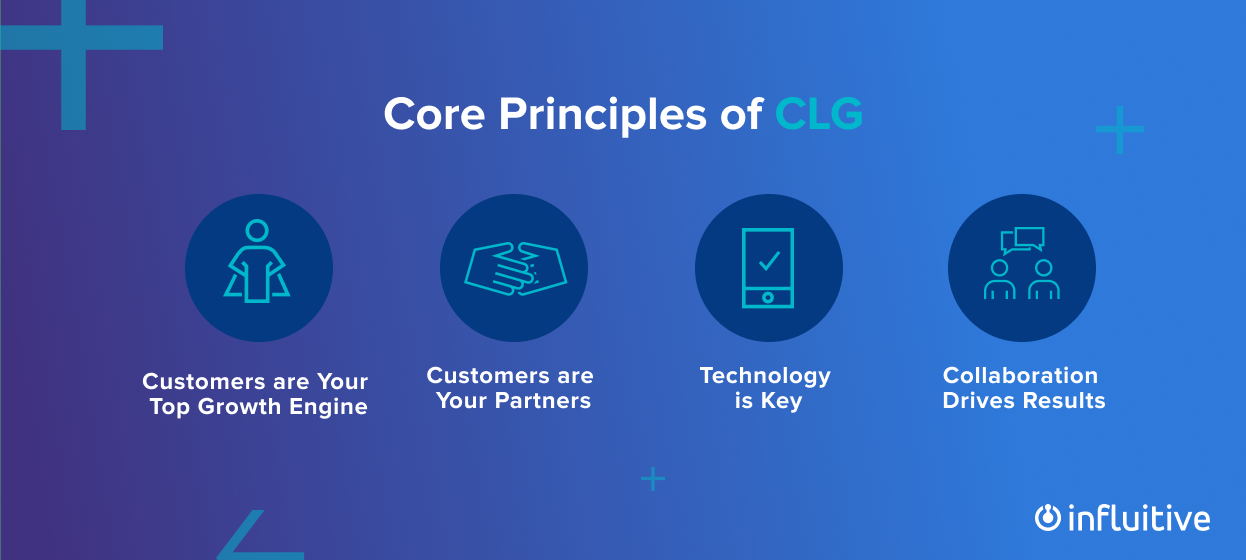
Customers are your top growth engine
Acquiring new customers costs 5X more than retaining and expanding with the ones you already have. CLG is about exploring how to increase revenue with customer retention, expansion, advocacy, and communities.
Collaboration drives results
CLG is an iterative process that requires ongoing communication between sales, marketing, product development, and customer success teams. Everyone needs to know how you’re gathering feedback — and why — what the next steps are (how to branch the action taken from the feedback), and how you’ll evaluate the results of your efforts.
Customers are your partners
Customers probably know your product better than you do, and that’s especially true for SaaS (Software as a Service) brands. Think of SaaS customers as a wide network of quality assurance testers. They’re interacting with software every day, and they may be using workarounds because the software doesn’t quite do what they need it to do. Gathering feedback from users can help SaaS brands expand their features and delight customers.
Technology is key
If you’re trying to engage thousands of customers around the world, you need a way to track, document, and analyze feedback. Top customer advocacy platforms help you do all of that and include templates and customizable automations, for flawless and perfectly timed interactions.
CLG vs PLG vs SLG vs MLG
CLG is just one type of growth model. Let’s take a quick look at the other types:
Customer-led growth (CLG): Customer-led growth is a strategic approach that prioritizes the needs and loyalty of customers above all else. By focusing on creating a positive and engaging experience for customers, businesses can achieve sustainable growth in the long run.
Product-led growth (PLG): PLG is essentially the inverse of CLG. Whereas CLG uses customer insights to develop products, PLG takes a product-led approach to growth strategies, letting the product sell itself through campaigns like freemium models and trial periods.
Sales-led growth (SLG): SLG is a growth model in which sales teams drive revenue. It’s most effective for companies that offer products or services based on a customer’s location. For example, food and beverage distributors might use SLG, sending sales teams into the field to pitch products to local restaurant owners.
Marketing-led growth (MLG): MLG drives growth with marketing materials as the main driver for inbound sales generation— advertising, blog content, white papers, landing pages, email, and digital newsletters, for example.
Event-led growth (ELG): ELG is all about growing revenue and customer loyalty with events – webinars, online, and in-person events.
Why more companies are adopting a customer-led growth model
The following 4 points are why companies are increasingly adopting CLG:
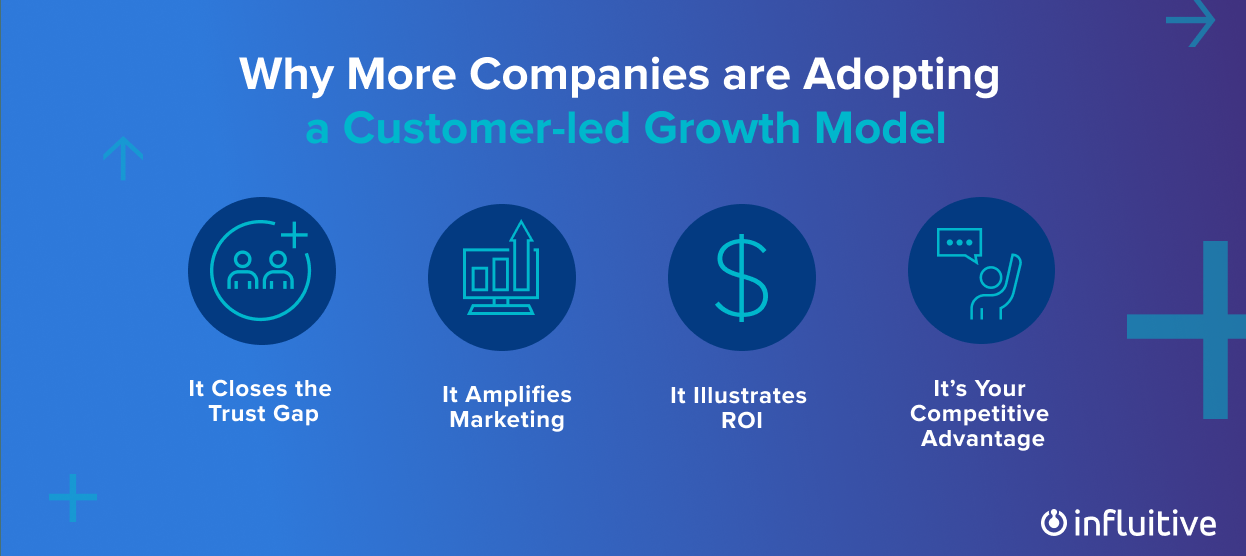
It closes the trust gap
Consumers trust referrals more than they trust your salespeople or marketing materials. CLG helps increase customer advocacy, including referrals — on your website, on social media, in customer forums, on one-to-one calls — that can drive new business. There is nothing more powerful than what people say about you when you’re not in the room.
It illustrates ROI
More than 75% of B2B buyers will look for three or more pieces of advocacy before converting. What are they looking for? Evidence that your product is a wise investment that will solve their problems. CLG fosters advocacy and generates customer success stories that clearly demonstrate your ROI, giving prospects the evidence they need to convert with confidence.
It amplifies marketing
Marketing teams are always juggling several strategic initiatives while trying to work as efficiently as possible. Implementing CLG helps you increase your marketing content exponentially — only, you’re not creating it yourself. Once you establish a CLG strategy that works, you’ll have a steady stream of customer-generated content you can use for marketing.
It is your competitive advantage
When done right, CLG focuses on giving customers exactly what they want, while optimizing their experience. It’s the best way to hold your customers’ attention when other companies are vying for it. Using a SaaS (Software as a Service) question as an example, which is more likely to retain customers: a company that proactively asks for and implements user feedback, or a company that treats feature requests like low-priority support tickets they try and mitigate?
9 steps for building a customer-led growth strategy
Building a customer-led growth strategy requires businesses to change how they approach customers. That starts with thinking of customers as partners, not just the people who pay for your services. With that fresh perspective, you can then use these nine steps to build out a strategy:
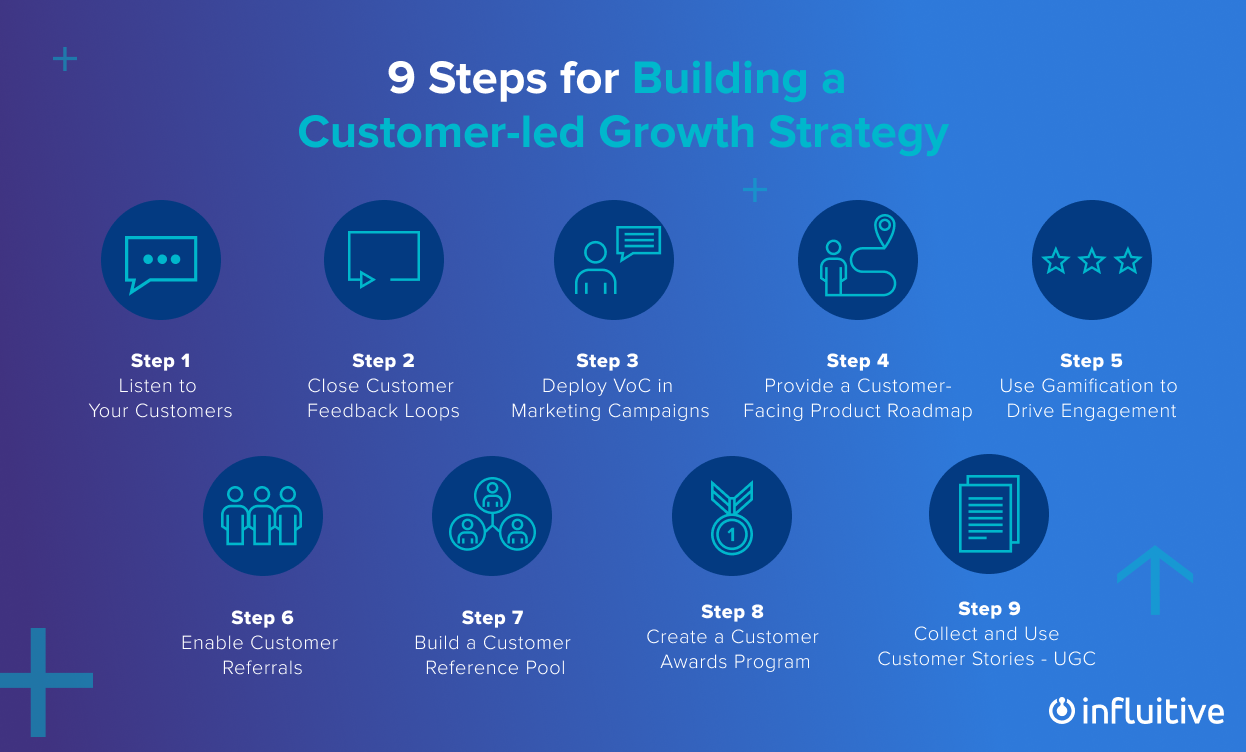
#1 Listen to your customers
The foundation for CLG is listening to customers — the ones you have now, and the ones you’ve lost.
New customers: Check in regularly with new users. Find out whether you’re meeting their expectations and learn how and why they chose your product. The insights you gather from new customers can help you improve your marketing strategies and ad targeting. You can leverage a host of scoring models and surveys including NPS (Net Promoter Score), CSAT (Customer Satisfaction), and CES(Customer Effort Score).
High-value customers: Take note of who your “power users” or brand evangelists are. Ideally, you’d want every customer to be in those categories, so it’s important to learn what differentiates your high-value customers from your moderately engaged customers.
Churned customers: Think of a lost customer as a learning opportunity. Try to re-engage churned customers to find out why they left. You may learn about a gap in your offering that your product development team could fill. This can be done by internal initiatives or sourced through win-loss analysis services providers.
Voice of the customer (VoC) programs help gather feedback on an individual level, based on their actions. For example, businesses might automate a follow-up email to ask for feedback on a customer’s recent purchase, and SaaS VoC campaigns might include in-app surveys about specific features, etc.
#2 Close customer feedback loops
When customers provide feedback, they’re doing you a favor. Show them your appreciation by explaining how you used that feedback to improve your product. For SaaS companies, that’s easy to do with an in-app message, like:
“You asked, and we delivered! With our new Adobe integration, you can work on your creative projects from within our platform.”
Keep the conversation going by gauging how customers feel about new features.
#3 Deploy VoC in marketing campaigns
Use the feedback from your VoC programs to power your marketing campaigns. You can repackage and repurpose your customers’ feedback for your product pages, social media, blogs, and other marketing material.
#4 Provide a customer-facing product roadmap
Creating a product roadmap for your customers shows them what updates are in progress, your upcoming priorities for new features, and your long-term plans for the product. Ask for input from your customers — maybe they want to see one of your long-term goals become a more immediate priority.
#5 Use gamification to drive engagement
With customer loyalty software, you can gamify engagement. For example, the Mountain Dew brand used Influitive to build its “DEW Nation HQ” hub for loyal customers. Fans can interact with each other and earn points for consuming content, social sharing, and product feedback. And a leaderboard shows points totals and rankings.
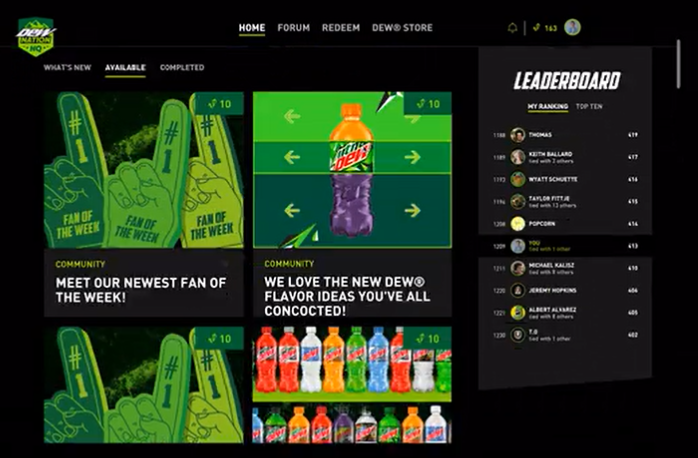
VMware’s loyalty program, VMware Rewards, recognizes and rewards customers in one centralized location. Even with hundreds of localized communities, VMware customers can earn points within the VMware communities they’re already active in and redeem them for swag, VMware experiences, as well as training and certification, all in one place, unifying the entire experience. Top engaged customers can even work their way up through various levels and earn VIP tier status, which lets them redeem big-ticket rewards.
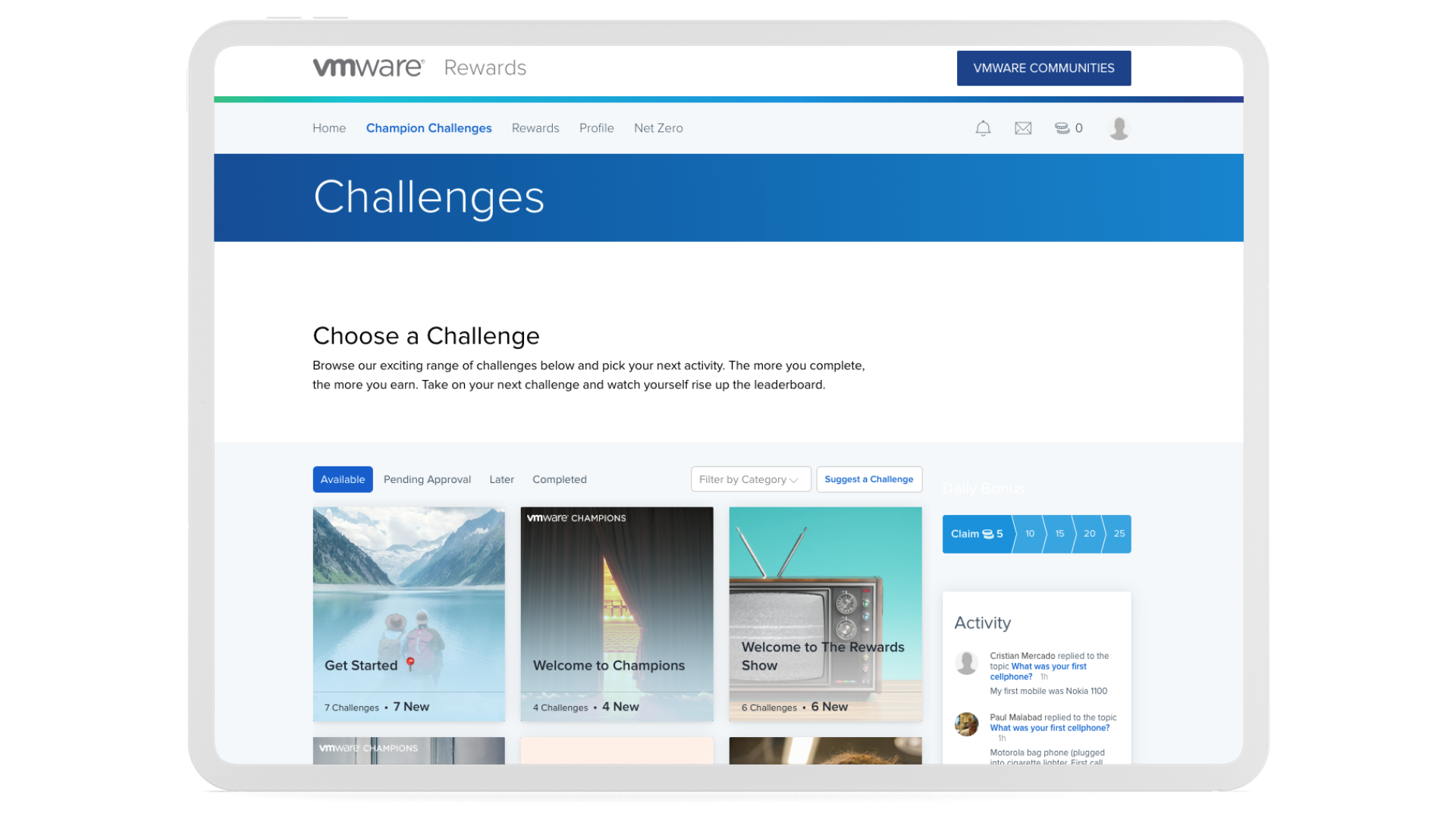
#6 Enable customer referrals
If you want referrals, make it easy for your customers to sing your praises, and offer them incentives for doing so. Create a landing page for your referral program and share the link with your customers. Even better: Create unique links for every customer, so you can easily track who’s sending you the most referrals. Finally, automate the gifting program to customize your approach at scale
#7 Build a customer reference pool
When considering B2B investments, decision-makers may want to ask questions of existing customers. Identify which customers are most engaged with your brand, product, or service, and nurture those relationships to build your pool of referenceable customers. Prospects who ask for these references and have a positive experience can then be invited into your reference program to continuously grow your pool.
#8 Create a customer awards program
Consider this the grand finale of all customer and advocacy programs within your portfolio. It’s how you set your north star for your champions to strive to be recognized and valued at the greatest level. Customer awards programs give your company the opportunity to celebrate your absolute best-of-the-best customers who will inspire the rest of your customers to aim high while seeing what’s realistically attainable.
#9 Collect and use customer stories – UGC (User Generated Content)
People purchase products and services to fulfill a need or solve a problem. Invite your customers to write a story, record testimonials, leave reviews, etc about how they use your product or service to achieve an objective.
Customer stories are more than just a snippet of feedback — they give your customer the opportunity to talk about their challenges, solutions they tried to implement, and what ultimately led them to your offering. The benefit for participating customers is more exposure for their brand.
I recommend focusing on these four things when asking customers to share:
- People – what’s the support and knowledge here vs competition
- Product – does the technology do what it says it’s going to do and how’s it different from your competition
- Programs – what was onboarding and the academy like vs comp, or what’s your community like to engage in, what maturity models or success plans have helped you adopt and optimize
- Performance – initial wins, value drivers, KPS, etc. Anything from go live, early adoption, first time to value, renewals, to expansion – or even just how it’s made them more proficient at their own jobs and got a raise (felt valued more)
Examples of customer-led platforms
Now that you know all about CLG, you may be wondering what technology you need to set it in motion. We’ve created a list of three top platforms for managing CLG — each of which also uses CLG to fine-tune its own software.
ON24
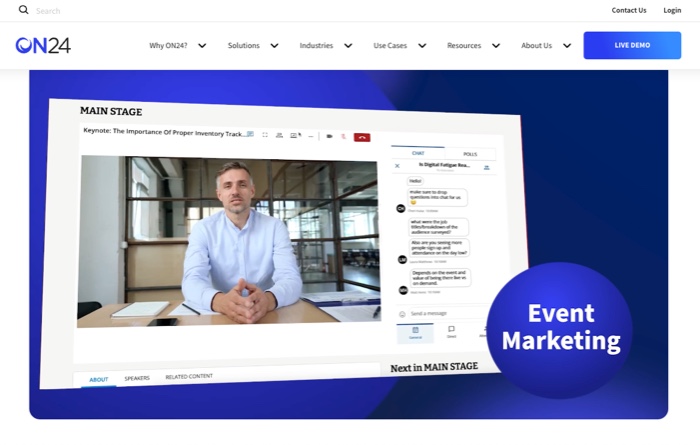
How it supports CLG:
ON24 is a CLG platform that helps businesses increase engagement with videos and webinars. You can see engagement analytics that shows how their content is performing and gather individual feedback through the app. You can also integrate ON24 with your existing CRM segmentation and automation, so you can preserve the processes that are already working for you.
How ON24 uses CLG:
ON24 analyzes how customers are using its product and adapts accordingly. For example, a pharmaceutical company that initially used ON24 to engage doctors began using the platform to engage patients after the COVID-19 pandemic began. ON24 then expanded its features to make its primarily B2B software suitable for B2C engagement. ON24 also offers their customers access to their Webinerd Community where they can network with their peers, and learn best practices and trends, all while getting recognized and rewarded for their contributions.
Influitive
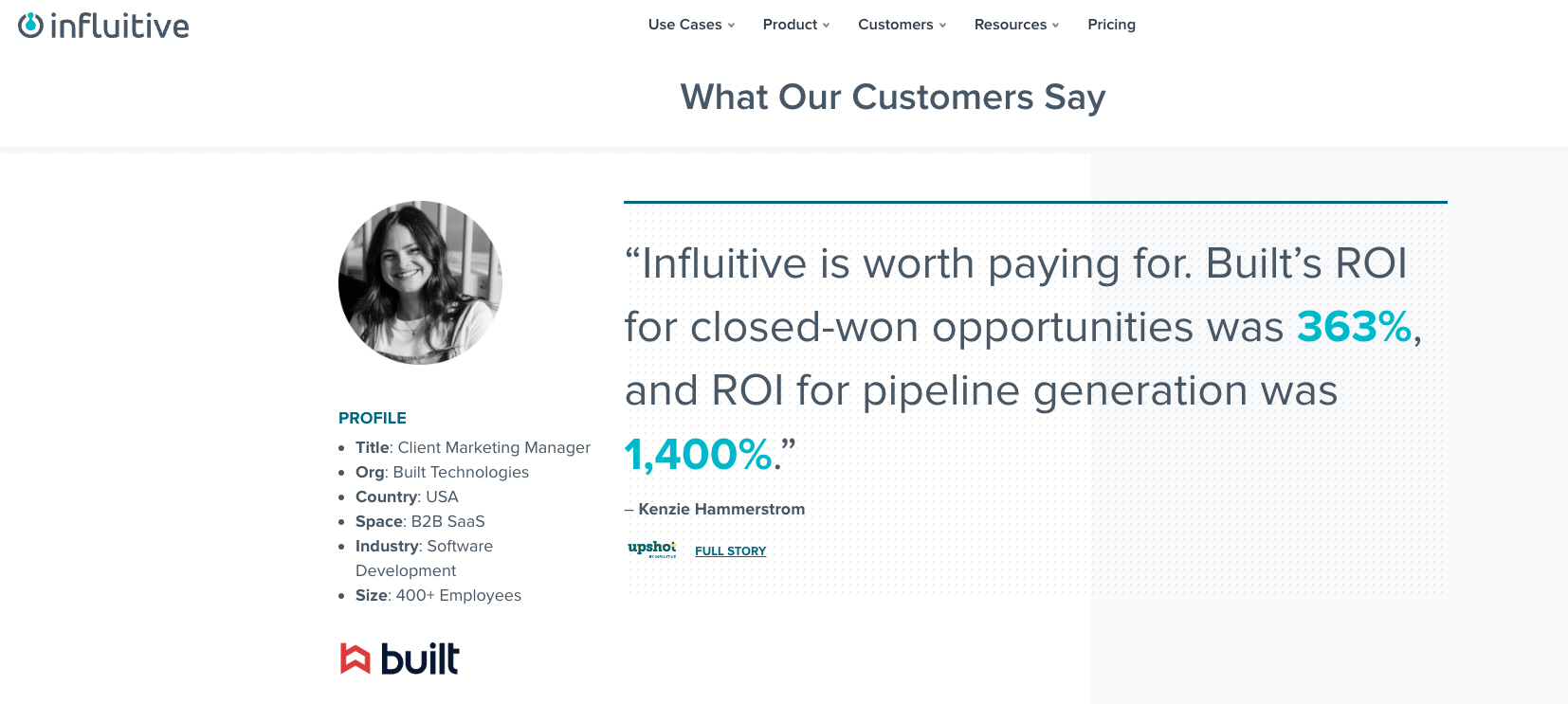
How it supports CLG:
Influitive helps B2B and B2C businesses manage every aspect of their CLG strategy. You can use it to onboard and train clients, grow product adoption, amplify social media, and engage users at any stage of the customer lifecycle. In 2022, Influitive’s customers used the platform to engage more than 585,000 users and generate a collective ROI of upwards of $211 million.
How Influitive uses CLG:
Influitive showcases its customer-created content in several ways. In addition to its testimonials page, Influitive has an in-depth customer stories page featuring posts from its customers. The combined social proof of the testimonials and stories allows would-be Influitive customers to explore how the platform could solve their problems. Influitive customers are also showcased at its annual Influitive Live conference and BAMMIES awards program.
Fullview
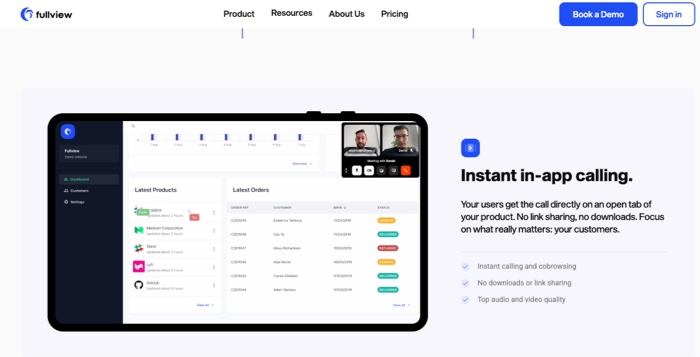
How it supports CLG: FullView is a platform for SaaS support teams that enables remote monitoring, co-browsing, and “instant replays” of functionality problems. The co-browsing feature lets SaaS companies nurture relationships with customers as they troubleshoot problems together.
How Fullview uses CLG:
Fullview uses customer input to prioritize and roll out new features. With each update, it creates content that provides a high-level overview of new features, and a more detailed walk-through (sometimes with animations and video).
Fuel customer-led growth with Influitive
Influitive gives you the tools you need to drive customer advocacy and gain insights that help you grow. Let us show you what we can do for you!








